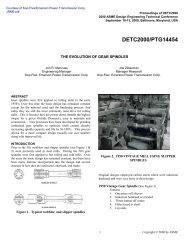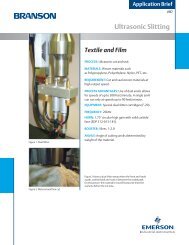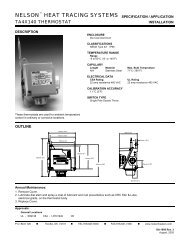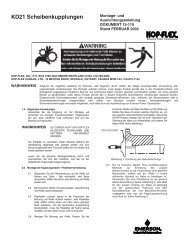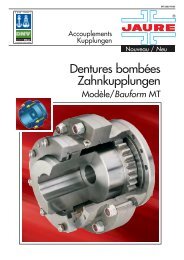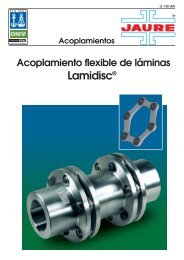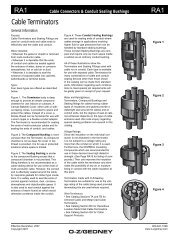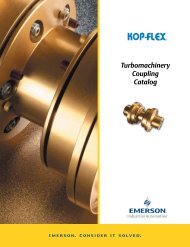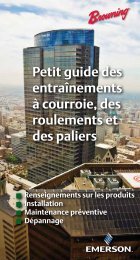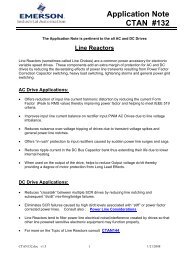Kop-Flex Industrial Coupling Product Catalog - Form 8887E
Kop-Flex Industrial Coupling Product Catalog - Form 8887E
Kop-Flex Industrial Coupling Product Catalog - Form 8887E
You also want an ePaper? Increase the reach of your titles
YUMPU automatically turns print PDFs into web optimized ePapers that Google loves.
Gear Spindles<br />
Lubrication and Troubleshooting<br />
Straight talk on spindle lubrication and troubleshooting<br />
How often should I lubricate?<br />
Normally once a week. However, frequent roll change<br />
causes a loss of lubricant. You may have to lubricate<br />
more under these circumstances, or possibly less under<br />
ideal conditions.<br />
How often should I inspect?<br />
You should completely disassemble and inspect each<br />
spindle at least once per year. We recommend that you<br />
use a spindle manufacturer to do this for you. We can<br />
repair worn spindles for less than the cost of a new one<br />
(see pages 214 and 215).<br />
What type of grease should I use?<br />
Use a non-lead grease with a minimum soap base of<br />
anhydrous calcium or lithium. The grease also should<br />
have additives for lubricity, rust prevention, adhesion,<br />
and extreme pressure. The base oil viscosity should be<br />
a minimum of 150 SUS at 210° F (100° C).<br />
KOP-FLEX recommends WAVERLY TORQUE<br />
LUBE-A*, which was developed especially for<br />
gear spindles (see pages 170-172). For high<br />
speed applications consult <strong>Kop</strong>-<strong>Flex</strong>.<br />
Why do spindles break down and what can I<br />
do to help prevent break down?<br />
There are three main causes of spindle breakdown:<br />
lubrication problems (causing normal wear, abrasive<br />
wear, scoring, and welding), sub-surface shear (pitting<br />
and spalling), and tooth breakage.<br />
Inadequate Lubrication Issues: Since gear teeth slide against each other during normal operation, some<br />
wear is inevitable, but premature or excessive wear is unacceptable. Wear can be classified as normal, abrasive, and<br />
scoring. Normal wear is usually slow and progressive and occurs over the service life of the teeth. Abrasive wear is<br />
usually rapid. Surface damage yields fine particles which rapidly accelerate tooth wear. Scoring usually occurs when<br />
the lubricant breaks down (or is ineffective for other reasons). Heat is generated, localized welding can occur, then<br />
destructive scoring takes place which is followed by torn out material, leaving pockets on gear tooth flanks. Poor<br />
contact and poor lubrication cause such problems. Here are five factors that contribute to inadequate lubrication:<br />
CAUSE<br />
(1) Using the wrong grease or not enough grease<br />
(2) Grease leaks from the seal<br />
(3) Rolling fluid washes grease from the gearing<br />
(4) High pressure-velocity (PV) values. A combination<br />
of high operating speeds and/or high misalignment<br />
causes high PV. High PV causes extreme temperatures,<br />
which cause the lubrication to break down.<br />
(5) Poor tooth contact. When few teeth are in contact,<br />
these teeth carry a disproportionate load. This then<br />
causes metal-to-metal contact, which generates localized<br />
hot spots (heat) and produces localized welding that<br />
causes tooth distress, destructive scoring, and welding.<br />
Poor tooth contact is due to either high operating misalignment<br />
or improper tooth shape (usually caused by heat<br />
treat distortion). Gears are often carburized to improve<br />
their strength but this distorts the teeth.<br />
CURE<br />
(1) Use special spindle grease, not bearing grease.<br />
Fill properly.<br />
(2) Check seals periodically. Consider replacing a<br />
lip seal with an all-metal rising ring seal.<br />
(3) Check the sealing of the thrust plate.<br />
(4) Use gearing with greater surface hardness, high<br />
operating speeds, high misalignment capacity, and a low<br />
coefficient of friction to address high PV, which causes<br />
extreme temperatures, (and breaks down lubricant).<br />
Increase the number of teeth under load to reduce the<br />
contact pressure on each tooth. Correct distortion by<br />
lapping or grinding.<br />
(5) If operating angles exceed the gear spindle’s<br />
design capacity, redesign the spindle. If misalignment<br />
is within original expectations, check the number of teeth<br />
in contact. If the number is too low it’s likely the teeth<br />
were excessively distorted during surface hardening<br />
(typical of induction hardened or carburized teeth) and<br />
not properly corrected by lapping or grinding.<br />
* Waverly Torque Lube-A is believed to be the trademark and/or trade name of Exxon Mobil Corporation and is not owned or controlled by Emerson Power Transmission.<br />
210





